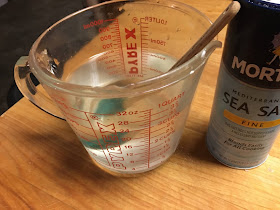He offered practical ways to improve gut health including eating fermented foods and shared his rather unconventional method to create sauerkraut . . . one quart at a time.
In the past I've tried the old-fashioned method — slicing, salting, partially covering and leaving for weeks. However, I've never been able to get past the mold that forms on top; despite directions to remove and proceed . . . I've thrown it away and vowed never to try again.
Dr. B's method uses a covered jar that is "burped" daily to remove the excess gas — NO mold involved! He usually begins eating the "sauerkraut" after about a week but it can go longer; he keeps several jars at various stages of development. He prefers a crunchy texture and said that he's addicted to the stuff.
After leaving the all day conference, I went home and immediately started a batch! It took a couple of days for the green cabbage to begin bubbling but once it started, the mixture began to smell like kraut! After seven days I tasted it — still slightly crunchy, pleasantly mild vinegar flavor . . . and yes, it is addictive!
Since then I started a jar of chopped red/purple cabbage with sliced garlic for additional flavor. It began to bubble almost immediately so can't wait to taste and do more experimentation.
Dr. B's Sauerkraut Method with my comments
- Chop the cabbage into whatever size pieces you like your kraut. (He likes thick so I've been doing that but will experiment with thinly sliced, too).
- Pack into a 1 quart Mason jar (fill jar about 75% full of cabbage). Feel free to add cloves of garlic, caraway seeds, or spices if you like. It's fun to experiment.
- Add a fermentation weight on top. (He orders "Pickle Pebbles" off Amazon. Instead, I folded a leaf of cabbage and placed over the cut cabbage and then weighted it down with glass marbles and decorative rocks that I secured in a sealable snack bag; this was at his suggestion.)
- Make a sea salt brine by mixing 1 cup of water (water should be boiled and cooled, or use distilled water to avoid chlorine) with 1 1/4 teaspoon SEA salt (do not use iodized salt). Taste the brine—it should taste salty but not so salty that you wouldn't take a sip.
- Pour the sea salt brine over the top of the cabbage and weight but still leave a little "head" room at the top.
- Cover the Mason jar and then "burp" the kraut by opening the lid once a day to release pressure from the gas that builds up. Dr. B uses a "Pickle Pipe" that allows the jar to burp on it's own; available on the internet.
- Place in cool location for 1 to 4 weeks to ferment. Once it's fermenting to your liking, begin eating and refrigerate at this point.
Recipe without photos . . .
Dr. B's Sauerkraut Method with my comments- Chop the cabbage into whatever size pieces you like your kraut. (He likes thick so I've been doing that but will experiment with thinly sliced, too).
- Pack into a 1 quart Mason jar (fill jar about 75% full of cabbage). Feel free to add cloves of garlic, caraway seeds, or spices if you like. It's fun to experiment.
- Add a fermentation weight on top. (He orders "Pickle Pebbles" off Amazon. Instead, I folded a leaf of cabbage and placed over the cut cabbage and then weighted it down with glass marbles and decorative rocks that I secured in a sealable snack bag; this was at his suggestion.)
- Make a sea salt brine by mixing 1 cup of water (water should be boiled and cooled, or use distilled water to avoid chlorine) with 1 1/4 teaspoon SEA salt (do not use iodized salt). Taste the brine—it should taste salty but not so salty that you wouldn't take a sip.
- Pour the sea salt brine over the top of the cabbage and weight but still leave a little "head" room at the top.
- Cover the Mason jar and then "burp" the kraut by opening the lid once a day to release pressure from the gas that builds up. Dr. B uses a "Pickle Pipe" that allows the jar to burp on it's own; available on the internet.
- Place in cool location for 1 to 4 weeks to ferment. Once it's fermenting to your liking, begin eating and refrigerate at this point.








Great instruction. Have you tried doing this in an oak barrel or bucket? I found old German books about this tradition. Some information and recipe here https://hoohla.cooking/what-is-homemade-sauerkraut
ReplyDelete